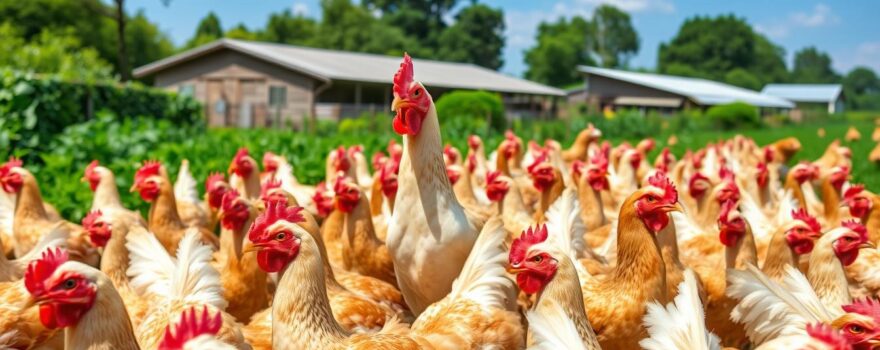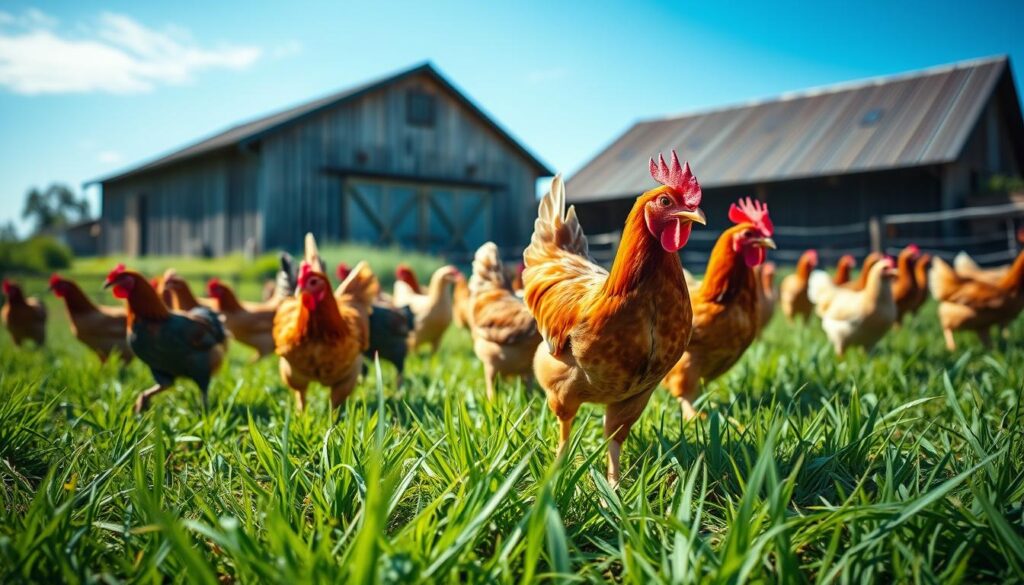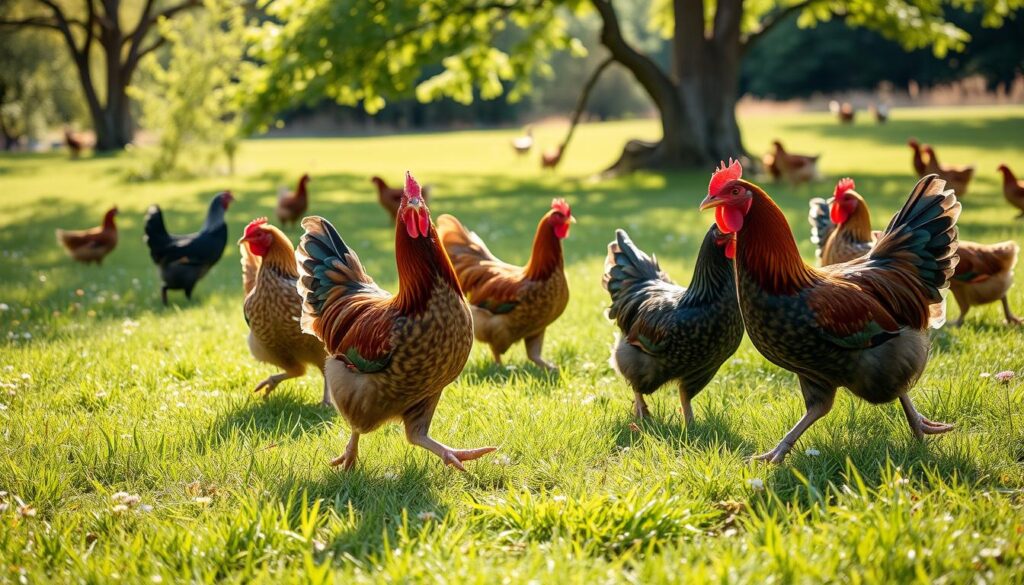
The world’s population is growing fast, making it hard to find affordable, nutritious food. Broiler chickens are a key player in solving this problem. This article looks at how broiler chicken production affects our food systems.
Broiler chickens grow quickly and turn feed into meat efficiently. Intensive poultry farming has made broiler meat cheap and available everywhere. But, this growth has also led to worries about its impact on the environment.
This analysis aims to understand the link between broiler chickens and food security. It covers the environmental effects, nutritional value, and safety of broiler meat. We’ll look at the challenges and opportunities in the future of food systems.
Key Takeaways
- Broiler chickens are crucial for global food security, offering affordable protein.
- The fast growth of intensive poultry farming worries us about its environmental impact.
- Finding a balance between the nutritional benefits of broiler meat and sustainable farming is key.
- Free-range and organic poultry farming are promising alternatives to traditional broiler farming.
- Good policies and regulations are vital for the long-term success of broiler chicken production.
The Rise of Broiler Chicken Production
The global poultry industry has seen a huge increase in broiler chicken production in recent years. This growth is due to the adoption of intensive farming practices. These practices are driven by economic factors and consumer demand.
Rapid Growth of Intensive Poultry Farming
The move to large-scale, industrialized poultry farming has driven the broiler chicken industry’s growth. Improvements in breeding, feed, and housing have boosted production. Now, broiler chickens can reach market weight in just weeks.
This makes the industry more able to meet the demand for affordable protein. It’s a key factor in the industry’s success.
Economic Factors Driving Broiler Demand
- Rising global population and urbanization have fueled the demand for affordable and convenient protein sources, such as broiler chicken meat.
- Changing dietary preferences and the growing popularity of fast food have contributed to the increasing consumption of broiler chicken, particularly in developing countries.
- Favorable economic incentives, such as government subsidies and low production costs, have made broiler chicken an attractive option for both producers and consumers.
| Economic Factor | Impact on Broiler Demand |
|---|---|
| Population Growth | Increased need for affordable protein sources |
| Urbanization | Shift towards convenient and processed food options |
| Government Subsidies | Lowering production costs and prices for consumers |
The combination of intensive farming and economic benefits has fueled the broiler chicken industry’s growth. It has become a major player in the global meat supply chain.
Environmental Impact of Broiler Chicken Farming
The demand for chicken meat is increasing worldwide. This has raised concerns about the environmental effects of broiler chicken farming. The methods used in modern broiler farms have big impacts on greenhouse gas emissions, water use, and land use.
Greenhouse Gas Emissions and Carbon Footprint
Broiler chicken farming is a big source of greenhouse gases, like carbon dioxide and methane. The production of feed, managing manure, and the energy needed for housing and processing all add to the carbon footprint. Studies have shown that the carbon footprint of broiler meat can be up to five times higher than that of plant-based protein sources.
Water and Land Resource Utilization
Broiler chicken farming also strains water and land resources. The feed grains needed and the water used for housing, cleaning, and processing can deplete freshwater and overuse land. Estimates suggest that broiler chicken production can require up to 2,300 gallons of water per pound of meat produced.
| Environmental Impact Metric | Broiler Chicken Farming | Plant-Based Protein |
|---|---|---|
| Carbon Footprint (CO2 eq. per kg) | 5.7 kg | 1.0 kg |
| Water Usage (gallons per pound) | 2,300 gallons | 460 gallons |
| Land Use (square meters per kg) | 22 m² | 3 m² |
The environmental impact of broiler chicken farming is a big challenge for the industry’s future. It affects the industry’s ability to help feed the world. To solve these problems, we need better farming practices, more plant-based options, and strong policies.
Broiler Chickens and Food Security: A Critical Analysis
The world’s population is growing fast, making broiler chickens key for food security. Broiler chickens grow quickly and use less food, making them a cheap and accessible protein source for many.
But, the link between broiler chickens and food security is complex. They can improve nutrition and calorie intake. Yet, their use has raised worries about the environment and animal welfare in intensive farming.
The environmental impact of broiler chicken production is significant. Their farming methods use a lot of resources and create waste. This could harm the food system’s long-term sustainability.
- Water and land usage: Broiler farming uses a lot of water and land, needed for food production.
- Manure management: The waste from big broiler farms is hard to manage, causing environmental harm.
- Feed sourcing: The need for high-protein feeds from far away adds complexity to the supply chain.
The welfare of broiler chickens in intensive farming is also a big concern. They face overcrowding, limited natural behaviors, and high stress. This raises questions about the morality and social impact of such farming.
“Balancing the need for affordable, accessible protein with the environmental and ethical concerns surrounding broiler chicken production is a critical challenge facing the global food system.”
To tackle these issues, we need new, sustainable ways to improve food security. These methods should reduce the environmental and ethical impacts of broiler chicken farming.

Nutritional Value and Safety of Broiler Meat
Broiler meat is a key protein source that helps ensure food security and supports a balanced diet. It’s important to look at the nutritional value and safety of broiler meat. This helps us understand its role in meeting our protein needs.
Protein Content and Nutrient Density
Broiler meat is known for its high protein content. A 3.5-ounce (100-gram) serving of cooked broiler meat has about 31 grams of protein. This is over 60% of what adults need daily. It’s also packed with vitamins and minerals like:
- Vitamin B6, which supports immune function and energy metabolism
- Niacin, which contributes to cardiovascular health and nervous system function
- Selenium, a powerful antioxidant that helps protect cells from damage
- Zinc, which is crucial for healthy growth, development, and wound healing
These nutrients make broiler meat a great source of protein. They also boost its nutrient density. This makes it a valuable and healthy part of a balanced diet.
But, we must also think about food safety with broiler meat. There are risks like bacterial contamination or antibiotics. It’s key to handle, store, and cook broiler meat safely to ensure it’s good to eat.
“Broiler meat is a rich source of high-quality protein, providing essential nutrients for a balanced diet and supporting food security.”
Animal Welfare Concerns in Broiler Production
The world’s need for chicken meat is growing fast. This has made people question how chickens are raised in broiler production. Animal lovers are worried about the chickens’ living conditions, especially overcrowding and stress.
Overcrowding and Stressful Living Conditions
Broiler chickens are often packed too tightly together. They get much less space than they need. This makes them stressed and uncomfortable.
Their living spaces are often empty and small. This can cause them physical and mental harm. They may start pecking at each other’s feathers, become aggressive, or even eat their own flesh.
Ethical Considerations in Intensive Farming
Many people are talking about the ethics of raising chickens this way. The industry says it’s needed to feed more people. But animal lovers say it’s wrong to ignore the chickens’ needs and natural behaviors.
Is it right to produce more food if it means animals suffer? This is a big debate. It’s about finding a balance between food needs and animal welfare.
More people are asking for better ways to raise chickens. This is changing how the broiler industry works. It’s about making sure we have food and treat animals right.
“The true measure of a nation’s moral progress is how it treats its animals.”
– Mahatma Gandhi
Sustainable Alternatives to Conventional Broiler Farming
The need for broiler chickens is growing fast. This has led to more focus on the environment and animal welfare in farming. Free-range and organic poultry farming are seen as better options. They are kinder to animals and gentler on the planet.
Free-Range Poultry Production
Free-range farming lets chickens move around outside. They get sunlight, fresh air, and can forage like they would in nature. This method lowers the risk of disease and stress in birds.
It also uses local grains and insects for food. This cuts down on the carbon footprint of raising chickens.
Organic Poultry Production
Organic farming goes even further. It ensures animals are treated well, fed right, and the environment is cared for. Organic chickens are raised without harmful chemicals or antibiotics.
They get to roam outside, which is better for their health and the planet. This method reduces pollution and saves water and land.
Free-range and organic farming are key to a better food system. They offer sustainable alternatives to traditional broiler farming. As more people learn about them, they could help solve big food security problems.

Food Security Challenges in Meat Supply Chains
The global food system faces big challenges in making sure everyone has access to affordable protein. Broiler chicken production has gone up a lot, but getting meat to people is hard. It’s important to understand how meat gets from farms to tables to solve these problems.
Distribution and Access to Affordable Protein Sources
Getting meat and other protein-rich foods to everyone is a big problem. Things like roads, trucks, and markets can make it hard. Also, meat can get too expensive for people who don’t have much money.
We need new ways to make meat supply chains better. Improving roads, building cold storage, and using subsidies can help. These steps can make sure everyone has access to the protein they need.
| Protein Source | Affordability Index (1-10, 10 being most affordable) | Availability Index (1-10, 10 being most widely available) |
|---|---|---|
| Broiler Chicken | 8 | 8 |
| Beef | 6 | 7 |
| Pork | 7 | 7 |
| Eggs | 9 | 9 |
| Legumes | 10 | 10 |
The table shows how different proteins compare in cost and availability. Broiler chickens and legumes are cheaper and easier to get. By fixing how meat gets to people, we can make food more fair and sustainable for everyone.
Balancing Meat Consumption and Environmental Impact
The world’s love for meat, especially broiler chicken, is growing fast. This makes it crucial to look at the environmental effects of this trend. We need to study how meat consumption affects our planet to ensure a sustainable future.
Broiler chickens are a big part of many diets. But, their production has a big environmental impact. It includes greenhouse gas emissions, water use, and land needs. The poultry industry is a big challenge for the food system’s sustainability.
To meet the demand for affordable protein and reduce environmental harm, we need a new approach. This could include:
- Supporting sustainable farming like free-range and organic poultry. These methods care for animals and save resources.
- Teaching people about the environmental effects of their meat consumption. Encourage them to eat more plants.
- Investing in research to make the broiler chicken industry more efficient and sustainable.
By understanding the link between meat consumption, environmental impact, and food security, we can aim for a better future. A future where everyone gets the nutrition they need without harming our planet.
| Metric | Conventional Broiler Farming | Sustainable Broiler Farming |
|---|---|---|
| Greenhouse Gas Emissions | High | Significantly lower |
| Water Usage | Extensive | Reduced |
| Land Requirement | Intensive | More efficient |
| Animal Welfare | Compromised | Prioritized |
“Sustainable meat production and consumption are essential for ensuring food security and environmental protection in the long run.”
By choosing a balanced and careful way to produce and consume meat, we can create a better future. A future where everyone gets the food they need without harming our planet.
Policy and Regulatory Frameworks for Sustainable Poultry Production
The demand for poultry meat is growing worldwide. Policymakers and regulatory bodies are key in shaping the broiler chicken industry’s future. They focus on sustainable production, animal welfare, and reducing environmental impact.
Standards for Animal Welfare and Environmental Protection
In the United States, government agencies and industry groups have set standards. These standards aim to improve animal welfare and protect the environment in broiler chicken farming. The U.S. Department of Agriculture has rules on stocking density, natural light, and enrichment materials for chickens.
The Environmental Protection Agency (EPA) also has strict rules. They cover waste management, water use, and greenhouse gas emissions in poultry farms. These rules help reduce the industry’s ecological impact and promote sustainable farming.